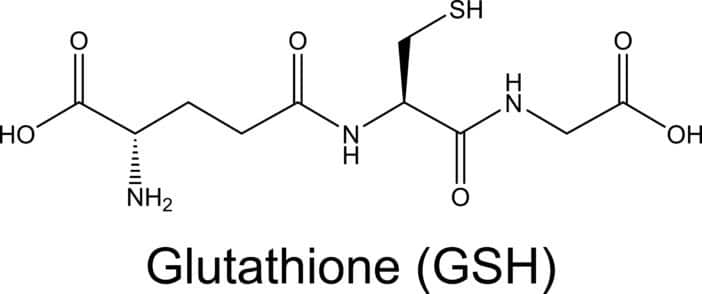Glutathione (GSH)

The protective and transformative power: detoxification and antioxidant protection
The functions of Glutathione (GSH) are wide-ranging and of fundamental importance for our health. One particularly outstanding function is the transformation of harmful substances in the body. It acts as a mediator that converts these harmful elements into water-soluble forms and thus enables them to be excreted via the kidneys. Pesticides, heavy metals, and specific drugs are just a few examples of the types of harmful substances that glutathione can deal with effectively.
In addition to this transformative role, it also plays an important role in protecting cells from the negative effects of free radicals. These highly reactive molecules can damage cell membranes and proteins, which in turn can lead to premature ageing and cell damage. Its ability to neutralise free radicals has led to it often being referred to as the “master antioxidant”. In the cosmetics industry, this property is valued and increasingly utilised in skin care products.
Challenges and future prospects: Glutathione (GSH) as a subject of research
Despite the exciting potential of glutathione in healthcare and cosmetics, it is essential that further research sheds light on the exact mechanisms and effects of this molecule. While it is available as a dietary supplement and has shown positive results, such as in animal research, clinical studies still need to take a closer look at its efficacy and safety in various applications. Especially at a time when environmental factors are increasingly affecting the endogenous production of GSH, there are interesting possibilities for the use of this “master antioxidant” to promote health and beauty.
Glutathione (GSH) and the ageing process
The body’s own Glutathione (GSH) levels fall from around the age of 45. This is due to a decline in its own synthesis. After the age of 60, the GSH status deteriorates even more drastically. Logically, this leads to a decline in the protective function, which in turn increases oxidative stress. Researchers therefore emphasise that the individual glutathione level has a significant influence on the ageing of each person. A comprehensive study from Denmark has already confirmed this theory. There is now also evidence that GSH has a positive effect on our skin. A three-month study showed that the administration of GSH can lead to improved skin elasticity. Compared to the placebo participants, a significant reduction in wrinkles was also observed. Experts therefore consider it to be an effective anti-ageing agent.
Glutathione in cosmetics
GSH is an excellent anti-ageing booster and gentle detox treatment. As the substance stops free radicals that not only damage our tissue and cells, but also destroy the collagen fibres responsible for skin elasticity, it could almost be described as a fountain of youth. Especially when you realise that GSH also stimulates important repair processes within our DNA, which also slows down the natural ageing process and contributes to a healthy, fresh complexion. Of course, it would be possible in principle to improve GSH levels through a specific diet. For example, vegetables with a particularly high sulphur content could help. These include Brussels sprouts, cauliflower and broccoli, onions, savoy cabbage and garlic. However, the age-related decrease in GSH levels cannot be relativised by diet alone. If you want to treat your skin to something good, you should therefore reach for high-quality cosmetic products with glutathione. So far, however, there are still few cosmetics with GSH, but this is likely to change in the future as the active ingredient has long been more than just a secret weapon. Care creams and serums with this ingredient can activate the skin’s own repair mechanisms and lead to a significantly better complexion.
In the cosmetics industry, glutathione is often promoted for its potential brightening properties for skin care and is often used for its supposed brightening effects on the skin. As a tripeptide, also abbreviated GSH, it helps to regulate the production of melanin, which is responsible for skin pigmentation. By inhibiting the activity of the enzyme tyrosinase, glutathione can help to reduce skin discolouration such as freckles, age spots and hyperpigmentation.
In addition, the substance plays a crucial role as an antioxidant. At a time when our skin is increasingly exposed to environmental stresses and free radicals, it provides a protective barrier. It helps to minimise the damaging effects of reactive oxygen species (ROS) on the skin. These ROS are responsible for premature skin ageing and cell damage. Glutathione’s ability to neutralise these ROS has led to it often being referred to as the ‘master antioxidant’.
Glutathione (GSH) profile
INCI: Glutathione
CAS number: 70-18-8
Description: white solid
Melting point: 185 to 195 degrees Celsius
Solubility: in water and dimethylformamide
Effect: extremely effective as a radical scavenger, detoxifies, stimulates natural repair processes
Areas of application: perfect as an innovative anti-ageing booster
We like to work with these glutathione-containing active ingredients:
| Trade Name | Company | INCI | Comment |
|---|---|---|---|
| L-Glutathione | Hangzhou Rebtech Novel Material Co., Ltd. | Glutathione | |
| iWhite Glutathione | KimiKa, LLC (Formerly Cosphatech) | Glutathione | |
| Glutathione GSH | WISDOMIT | Glutathione | |
| SpecKare GSH (L-Glutathione Reduced) | Spec-Chem Industry Inc | Glutathione | |
| PromaCare GSH | Uniproma | Glutathione | |
| Cosroma GSH | COSROMA | Glutathione | |
| AC-GSH | SOHO ANECO Chemicals Co., Limited | Glutathione | |
| SpecKare GSH | Spec-Chem Industry Inc | Glutathione | |
| SpecKare GSSG | Spec-Chem Industry Inc | Oxidized Glutathione | |
| MVP Sapphire Lift Solution | Infinitec | Water , Xanthan Gum , Synthetic Sapphire , Glutathione , Palmitoyl Tripeptide-28 | |
| NanoWhite | Mibelle AG Biochemistry | Lecithin , Arbutin , Linolenic Acid , Linoleic Acid , Tocopheryl Acetate , Ascorbyl Palmitate , Glutathione , Alcohol , Aqua | |
| Natori Vita Complex HD | Ecoori | Biotin , Panthenol , Thiamine HCl , Cyanocobalamin , Riboflavin , Pyridoxine , Folic Acid , Menadione , Bioflavonoids , Ascorbic Acid , Tocopheryl Acetate , Glutathione , 1,2-Hexanediol , Water |
Glutathione (GSH) for sophisticated formulations from Cosmacon
Glutathione (GSH) can actually be described in just one sentence: The tripeptide is “the mother of all antioxidants”. The valuable radical scavenger can improve the structure of mature skin and reduce wrinkles. Cosmacon will be happy to formulate exclusive premium cosmetics with glutathione for you.
Sources:
Systemic Glutathione as a Skin-Whitening Agent in Adult.; Sitohang IBS, Ninditya S.Dermatol Res Pract. 2020 Apr 24;2020:8547960.
Efficacy and safety of S-acyl glutathione 2% cream vs. placebo against UVB-induced erythema: a randomized, double-blinded clinical trial.; Grandi V, Milanesi N, Sessa M, Gola M, Cappugi P, Pimpinelli N.G Ital Dermatol Venereol. 2019 Dec;154(6):632-637
Odorless Glutathione Microneedle Patches for Skin Whitening.; Lee Y, Kumar S, Kim SH, Seong KY, Lee H, Kim C, Jung YS, Yang SY.Pharmaceutics. 2020 Jan 27;12(2):100
Protective effect of curcumin against ultraviolet A irradiation‑induced photoaging in human dermal fibroblasts.; Liu X, Zhang R, Shi H, Li X, Li Y, Taha A, Xu C.Mol Med Rep. 2018 May;17(5):7227-7237.
Intravenous glutathione for fair skin; to give or not to give?; Jamali M, Majid A.J Pak Med Assoc. 2017 Jul;67(7):1127.
Evaluating Oral Glutathione Plus Ascorbic Acid, Alpha-lipoic Acid, and Zinc Aspartate as a Skin-lightening Agent: An Indonesian Multicenter, Randomized, Controlled Trial.; Sitohang IBS, Anwar AI, Jusuf NK, Arimuko A, Norawati L, Veronica S.J Clin Aesthet Dermatol. 2021 Jul;14(7):E53-E58.
